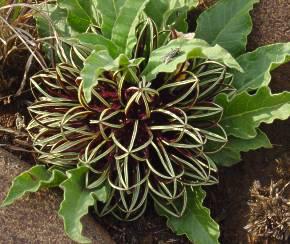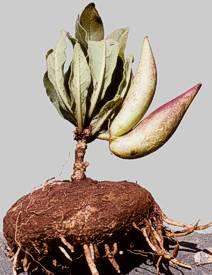Brachystelma barberae
Brachystelma barberae Harv. ex Hook.f.
Family: Apocynaceae
Common names: platvoetaasblom (Afr.)
Introduction
Brachystelma barberae is without doubt the most spectacular species in the genus. It is probably the best known cultivated caudiciform asclepiad. If the bizarre, cage-like, many-flowered head does not draw attention, the rotting smell of the flowers will surely elicit a response. The colour, odour and segments of the flower that are united at the tips, are reminiscent of a decaying carcass.

Description
Description
Brachystelma barberae is a perennial, geophytic dwarf herb. One to a few short annual stems are produced from a disc-shaped underground tuber (potato-like structure) that ranges from 80-200 mm in diameter. The tuber is depressed in the centre and becomes irregular in shape with age. All the above-ground parts are covered with coarse hairs and produce a watery sap when damaged.

The simple, opposite leaves are oblong (up to 100 x 25 mm) with short petioles. There can be as many as fifty striking flowers arranged in one to three large, spherical masses close to the ground. The flowers have an extremely unpleasant scent and sometimes precede the leaves, opening in rapid succession, usually within 2-3 days. The corolla is tube to bell-shaped and the inner surface has crimson-brown bands on a yellowish background. The slender lobes are united into a cage-like structure at the tip which is greenish on the outside and maroon to crimson-brown on the inside.

The plants flower in spring and early summer with a peak from October to December. The fruit is a follicle with a thick, smooth, velvety pericarp of 120 x 30 mm. After fertilization, two follicles may develop from each flower but sometimes one aborts. The seeds are numerous and tightly packed within the fruit.

In Brachystelma, either a tuber (as in B. barberae) or a cluster of fleshy, spindle-shaped roots as in B. gerardii are produced. The flowers vary greatly in size and shape from delicate (B. chloranthum) and small (B. nanum) to large with an even more potent odour (B. foetidum).
Conservation Status
Status
Currently, Brachystelma barberae is not threatened. Although scattered throughout its distribution range many herbarium records indicate that the species may be locally common in some localities. It is thought that the distribution of this species is affected by its use as a food source by both people and animals to some extent.
Distribution and habitat
Distribution description
Brachystelma is found in Africa, India and Australia. About 80 of the 120 species are found in southern Africa where they are widespread but rarely common. Brachystelma barberae is the most profuse and widespread species in the genus. It is found mainly in grassland and savanna and is generally rare but may be very abundant locally. This species is found at altitudes of 400 to 1300 m in Botswana, South Africa (Eastern Cape, Gauteng, KwaZulu-Natal, Mpumalanga, North-West and Limpopo Provinces) and Zimbabwe.
The species grows in well-drained, sandy to loamy, rocky, stony or gravelly soils, usually in full sun but sometimes also in light shade.
Derivation of name and historical aspects
History
The name Brachystelma is derived from the Greek words brachys, meaning short, and stelma, meaning column or crown. The epithet barberae honours Mrs Mary Elizabeth Barber (1818-1899), a well-known botanical artist from the Eastern Cape Province. The original description was based on a painting by Mrs Barber (née Bowker) of a plant that came from the Tsomo River Valley in the former Transkei.
In its tribe, only the genus Ceropegia has more species than Brachystelma.
Ecology
Ecology
Insects are attracted by the putrid odour of the flowers where they are then deceived to lay eggs. Mainly flies, but also other insects, are responsible for pollination. Reese (1973) gives an overview of the highly specialized flowers and the pollination process in the Stapeliae, which are very similar to this group.

At a distance, insects are primarily attracted by the foul-smelling nectar. Closer to the flowers the coloration and moving hairs are responsible for secondary attraction. The pollen is packed into two joined units called pollinaria (the structure as a whole is known as the pollinium). In the platvoetaasblom the pollinia are loosely attached and are deposited onto the insect (usually its proboscis) when it searches for nectar or a suitable place to lay its eggs. The pollinia are then carried to another flower as the insect moves between flowers.

In general, because of the specialized pollination syndrome, fertilization has a low percentage of success. However, large quantities of seed are produced per fruit.
In Brachystelma barberae, the fruit has an after-ripening period, usually until spring about a year after fertilization. The pedicel thickens as it provides nourishment for the growing fruit and seed. Mature fruit bursts open lengthwise. The seeds are adapted to wind dispersal; each one has a tuft of white hairs opening into a parachute-like structure when dry, helping it to be carried off for dispersal by the slightest breeze. As the seed with its tuft of hairs dries off after it has been released, the two structures become detached and the seed germinates and starts growing, if it has landed in a favourable spot.
The size of the tubers is related to the age of the plant. The age of one of about 200 mm diameter is likely to be 10 to 20 years and it is also likely to be considerably tougher. The tuber is a storage organ for both food and water. In autumn plants lose their leaves and go into a dormant state until the next spring.
Uses
Use
Tubers are known to be eaten as a food supplement in rural areas when food is in short supply. It is part of the daily food supplement of traditional San people. Wild animals such as porcupines, baboons, rodents and certain insects are also fond of the tubers. It is therefore a survival food for both plants and animals. The tubers are also a definite source of water in the dry habitats where the plant occurs.
Although this species is not specifically mentioned for medicinal use in the literature, many of the tuberous brachystelmas are known to be used medicinally for headache, stomach ache and colds in children.
This species, although not too rare, is sought after by collectors.
Growing Brachystelma barberae
Grow
It is a real challenge to grow and maintain good specimens as the plants are prone to rot.
The best way to reproduce this species is by growing it from seed and the fresher the seed, the better the results. Collect seeds as soon as the mature fruit starts to burst open. The seeds can be stored for about a year in normal air. Ash from firewood can be used as an insect deterrent when seeds are stored.
Seeds germinate easily. Use a sandy medium for germinating. Cover the seeds in a seed tray with 5-7 mm of sand and treat the medium with fungicide. Keep the germinating medium damp until the seedlings are about 5 cm high. Prick out seedlings carefully so as not to damage the roots. Plant in a well-drained soil mix (4 parts fine and 4 parts coarse river sand; 1 part sieved, well-rotted compost; 1 part perlite; 1 part vermiculite).
A light, sandy soil with a little old compost is likely to give satisfactory results. This species is very sensitive to frost and a challenge to even the best growers. Ensure good drainage when the plants are actively growing and instant dryness once they go dormant. If kept wet during their rest period, they will rot at a remarkable speed and even turn into a mass of watery slime within a day or two. Do not be lavish with artificial fertilizers, be frugal with watering generally and heed the natural resting periods.
Plants are mostly grown as container subjects in collections in controlled environments, but may also be grown in rock gardens in areas where they occur naturally.
References
- Barkhuizen, B.P. 1978. Succulents of southern Africa. Purnell, Cape Town.
- Dyer, R.A. 1980. Flora of southern Africa 27,4. Botanical Research Institute, Pretoria.
- Dyer, R.A. 1983. Ceropegia, Brachystelma and Riocreuxia in southern Africa. Balkema, Rotterdam.
- Hardy, D. & Fabian, A. 1992. Succulents of the Transvaal. Southern Book Publishers, Halfway House. South Africa.
- Leistner, O.A. (ed.). 2000. Seeds plants of southern Africa: families and genera. Strelitzia 10. National Botanical Institute, Pretoria.
- Nichols, G. 2005. Growing rare plants: a practical handbook on propagating the threatened plants of southern Africa. South African Botanical Diversity Network Report No. 36. SABONET, Pretoria.
- Oliver, I.B. 1998. Grow succulents. Kirstenbosch Gardening Series. National Botanical Institute, Cape Town.
- Pole Evans, I.B. 1929. Brachystelma barberae. The Flowering Plants of South Africa 9: t. 235.
- Reese, G. 1973. The structure of the highly specialized carrion-flowers of stapeliads. Cactus and Succulent Journal ( US ) 45: 18-29.
- Rowley, G.D. 1987. Caudiciform and pachycaul succulents. Strawberry Press, California.
- Smith, C.A. 1966. Common names of South African plants. Memoirs of the Botanical Survey of South Africa No. 35.
- Van Wyk, B. & Malan, S. 1997. Field guide to the wildflowers of the Highveld. Struik, Cape Town.
- Watt, J.M. & Brandwijk, M.G. 1962. The medicinal and poisonous plants of southern and eastern Africa. Livingstone, Edinburgh and London.
Credits
S.P. Bester
Pretoria National Herbarium
September 2008
Plant Attributes:
Plant Type: Bulb, Perennial
SA Distribution: Eastern Cape, Gauteng, KwaZulu-Natal, Limpopo
Soil type: Sandy
Flowering season: Spring, Early Summer
PH:
Flower colour: Brown, Green, Red
Aspect: Full Sun
Gardening skill: Challenging
Special Features:
Horticultural zones









Rate this article
Article well written and informative
Rate this plant
Is this an interesting plant?
User Comments
Trevor Whiting, South Africa
November 15, 2016 at 5:54 PMI cannot seem to find the plant anywhere. Can anyone assist?
Login to add your Comment
Back to topNot registered yet? Click here to register.